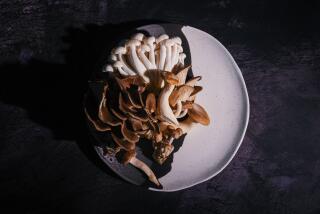From under their beds to into your walls
- Share via
TROY, N.Y. — Eben Bayer grew up on a Vermont farm learning the intricacies of mushroom harvesting with his father. Now the Rensselaer Polytechnic Institute graduate is using that experience to create an organic insulation made from mushrooms.
More at home on a pizza, mushrooms certainly aren’t a typical building material, but Bayer thought they just might work when given the assignment two years ago to create a sustainable insulation.
Combining his agricultural knowledge with colleague Gavin McIntyre’s interest in sustainable technology, the two created their patented “Greensulate” formula, an organic, fire-retardant board made of water, flour, oyster mushroom spores and perlite, a mineral blend used in potting soil. They’re hoping the invention will soon be part of a growing market for eco-friendly products.
Bringing the insulation to market is still at least a year away, said McIntyre, and will require much more research and work, not to mention more sophisticated equipment and a better work space.
“We’ve been growing the material under our beds,” said McIntyre, adding that they’ve applied for a grant from the National Collegiate Inventors and Innovators Alliance.
The two young developers -- Bayer is 21, McIntyre 22 -- graduated in May from Rensselaer with dual majors in mechanical engineering and product design and innovation.
“I think it has a lot of potential, and it could make a big difference in people’s lives,” said Rensselaer Professor Burt Swersey, whose Inventor’s Studio course inspired the product’s creation. “It’s sustainable and enviro-friendly, it’s not based on petrochemicals and doesn’t require much energy or cost to make it.”
The two say recent tests at the National Institute of Standards and Technology have shown it to be competitive with most insulation brands on the market.
With a rapidly increasing global population, a limited supply of natural resources and rising energy prices, eco-friendly housing products are selling fast. Numerous companies have carved out their niche selling “green” building supplies such as recycled fiber board and plant-based paints. The Environmental Home Center in Seattle sells an insulation made from denim scraps and another made from 100% recycled paper among their many green building products.
After looking through about 800 patents, though, Bayer and McIntyre realized they’d hit upon a relatively original idea. Unlike many green building products, Greensulate isn’t made from existing materials. It requires little energy or expense to produce because it’s grown from organic material.
Here’s how it works: A mixture of water, mineral particles, starch and hydrogen peroxide is poured into 7-by-7-inch molds and then injected with living mushroom cells. The hydrogen peroxide is used to prevent the growth of other specimens within the material.
Placed in a dark environment, the cells start to grow, digesting the starch and sprouting thousands of root-like cellular strands. A week to two weeks later, an inch-thick panel of insulation is fully grown. It’s then dried to prevent fungal growth, making it unlikely to trigger mold and fungus allergies, Bayer said. The finished product resembles a cracker in texture.
For Bayer and McIntyre, their next step will be creating larger pieces of Greensulate to use in building a wall. From there, they’ll perform further testing to see how the product stands up to various elements, including saturation and humidity.
As part of their development plan, they’re entering a new business incubation program at the institute to get their company, Ecovative Design, off the ground. Eventually, they hope another company will be a partner.
More to Read
Inside the business of entertainment
The Wide Shot brings you news, analysis and insights on everything from streaming wars to production — and what it all means for the future.
You may occasionally receive promotional content from the Los Angeles Times.










